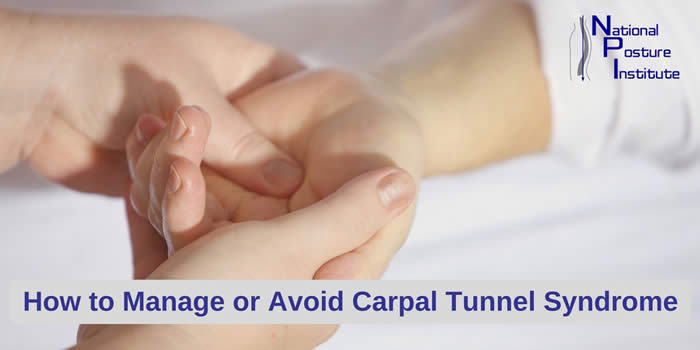How to Manage or Avoid Carpal Tunnel Syndrome
by Nick A. Titley, M.S., NPI-Certified Posture Specialist
If you spend large amounts of your time on a computer or mobile device then you most certainly need to understand carpal tunnel syndrome and how it develops. Are you ignoring a stubborn tingling or numb pain in your wrists? You may already have symptoms and not realize it. This article is for everyone as anyone can develop the symptoms of carpal tunnel syndrome and not realize it.

The National Institute of Neurological Disorders and Stroke (NIH) website says that carpal tunnel syndrome (CTS) occurs when the median nerve, a nerve that runs from the forearm into the palm, becomes pressed or squeezed at the wrist. This median nerve controls sensations in the palm side of the thumb and fingers, and is also responsible for sending impulses to some of the small muscles in the hand that allow it to move.
NIH also explains that the carpal tunnel—a narrow, rigid passageway of ligament and bones at the base of your hand—houses the median nerve and tendons. Swelling or thickening from irritated tendons causes the tunnel to narrow and compresses your median nerve. The results are painful; You may also suffer weakness or numbness in your hand and wrist that radiates up the arm. If this pain becomes persistent, you may already have carpal tunnel syndrome.
Carpal tunnel syndrome (CTS) starts gradually and is known for intermittent numbness and tingling in your thumb, index and middle fingers. Women are three times more likely than men to develop CTS, because the carpal tunnel may be smaller in women. The dominant hand is usually affected first and produces the most severe pain. The Mayo Clinic website says that you may experience numbness while performing various activities of daily living and you may also drop things due to weakness in your thumb’s pinching muscles.
The National Health Service (NHS) website lists a number of factors that contribute to CTS’s development. A family history of CTS, pregnancy, wrist injuries, health problems like diabetes and rheumatoid arthritis, and strenuous, repetitive work can cause this issue to develop. If CTS becomes severe, you may need surgery to sever the band of tissue around the wrist to reduce pressure on the median nerve.
When you hear carpal tunnel syndrome, most people think of desk jobs, however CTS is not confined to just manufacturing, assembly line or office work; if you engage your wrists daily (e.g. typing, drawing, writing, hairdressing) then you could develop it. You can also develop CTS if you have poor wrist alignment and use improper form while exercising. While a number of factors contribute to this problem it only affects adults and it’s an overuse injury that can be treated.
Take a moment to consider all that you’ve read thus far; please understand that CTS can be treated and in most cases avoided, do not allow this to become a part of your life. Start taking breaks during your job. Stretch your wrists often and allow your arms to sit comfortably in neutral position whenever possible, i.e. arms at your sides with your palms facing inward or toward the body in a relaxed position.
Be aware that weak wrist flexors and extensors contribute toward CTS. Strengthen your wrists by performing exercises and, once again, ensure you stretch them frequently. You need to pay attention to your wrists while engaging in your activities of daily living. Look at the way you use your wrists while driving and performing exercises. Your wrists should be relaxed and not constantly flexed or tensed, and if at all possible kept in neutral position i.e. palms facing toward the body.
Carpal tunnel syndrome is an overuse injury that causes pain, numbness and tingling in the wrist. It can become so severe that you need surgery. CTS can be avoided by proper wrist alignment, exercise and stretching, and by paying closer attention to the way you perform your daily activities. Try to reduce repetitive motions and employ proper care techniques.
References:
- "Carpal Tunnel Syndrome: Fact Sheet." Carpal Tunnel Syndrome: Fact Sheet. The National Institute of Neurological Disorders and Stroke, 17 Apr. 2015. Web. 22 Oct. 2015.
- "Carpal Tunnel Syndrome." Mayo Clinic. Mayo Clinic, 2 Apr. 2014. Web. 22 Oct. 2015.
- "Carpal Tunnel Syndrome ." Carpal Tunnel Syndrome. National Health Service, 18 Sept. 2014. Web. 22 Oct. 2015.
|